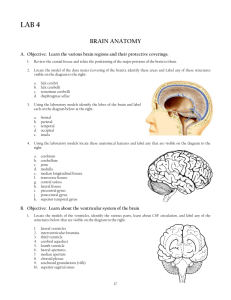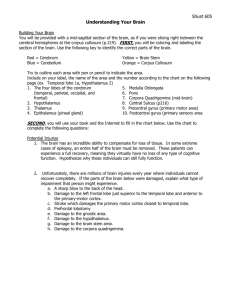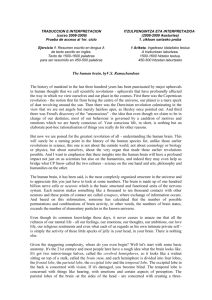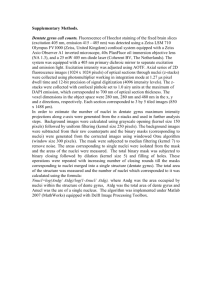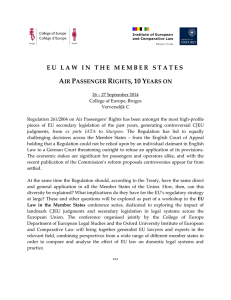VIII. 3. Functional Brain Mapping During Actual Car Driving: A FDG
advertisement
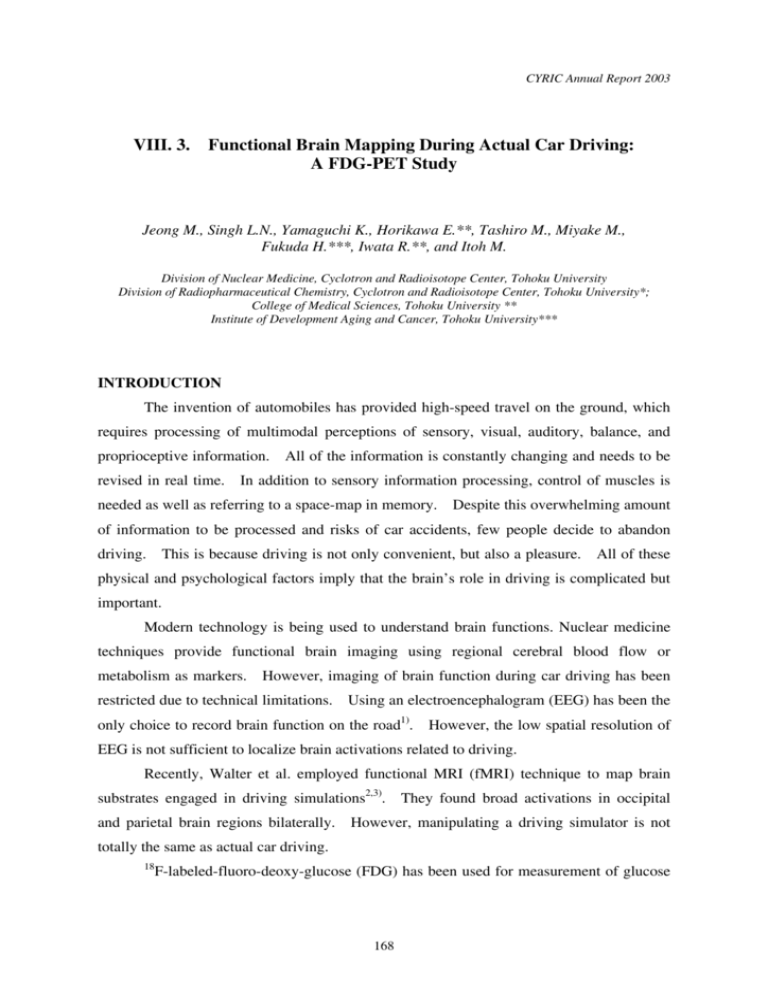
CYRIC Annual Report 2003
VIII. 3.
Functional Brain Mapping During Actual Car Driving:
A FDG-PET Study
Jeong M., Singh L.N., Yamaguchi K., Horikawa E.**, Tashiro M., Miyake M.,
Fukuda H.***, Iwata R.**, and Itoh M.
Division of Nuclear Medicine, Cyclotron and Radioisotope Center, Tohoku University
Division of Radiopharmaceutical Chemistry, Cyclotron and Radioisotope Center, Tohoku University*;
College of Medical Sciences, Tohoku University **
Institute of Development Aging and Cancer, Tohoku University***
INTRODUCTION
The invention of automobiles has provided high-speed travel on the ground, which
requires processing of multimodal perceptions of sensory, visual, auditory, balance, and
proprioceptive information.
All of the information is constantly changing and needs to be
revised in real time. In addition to sensory information processing, control of muscles is
needed as well as referring to a space-map in memory.
Despite this overwhelming amount
of information to be processed and risks of car accidents, few people decide to abandon
driving.
This is because driving is not only convenient, but also a pleasure.
All of these
physical and psychological factors imply that the brain’s role in driving is complicated but
important.
Modern technology is being used to understand brain functions. Nuclear medicine
techniques provide functional brain imaging using regional cerebral blood flow or
metabolism as markers. However, imaging of brain function during car driving has been
restricted due to technical limitations. Using an electroencephalogram (EEG) has been the
only choice to record brain function on the road1).
However, the low spatial resolution of
EEG is not sufficient to localize brain activations related to driving.
Recently, Walter et al. employed functional MRI (fMRI) technique to map brain
substrates engaged in driving simulations2,3).
and parietal brain regions bilaterally.
They found broad activations in occipital
However, manipulating a driving simulator is not
totally the same as actual car driving.
18
F-labeled-fluoro-deoxy-glucose (FDG) has been used for measurement of glucose
168
metabolism in the brain.
FDG, which is trapped in the cells after conversion to
FDG-6-phosphate by hexokinase, works as a molecular memory of cellular energy
metabolism.
The trapping phase lasts around 45 minutes after intravenous injection of
FDG. Using this advantage, functional brain imaging is possible outside of laboratories.
In this experimental design, we employed FDG-PET to visualize the roles of the brain
during car driving.
MATERIALS AND METHODS
Thirty healthy male volunteers, all right-handed, aged 20 to 56 years, participated in
this study.
A written informed consent was obtained from each subject after
full-explanations of the protocol.
The study was approved by the Clinical Review
Committee on Radioisotope Studies at Tohoku University Postgraduate Medical School.
The volunteers were divided into three groups: (A) driving group; 10 subjects with mean
age of 35.8 years (SD ±12.2) who drove on an ordinary road; (B) passenger group, 10
volunteers (34.8±13.1 years) participated as a passenger in the front passenger seat; and (C)
control group, 10 volunteers (32.7±9.6 years), remained in a comfortable seat inside an
experiment room.
The driving group drove a car with automatic transmission for 30 minutes around a
university campus immediately after intravenous injection of
18
F-FDG, average 40.7 MBq
(1.1 mCi). After micturition and preparation for a PET scan they were scanned with PET as
described below.
The same procedure was used for the passenger group, except that they
sat silently facing forward beside the driver during driving.
The control group were
injected with FDG, average 40.7 MBq (1.1 mCi), and remained in a lit PET waiting room
with their eyes open and without earplugs for the same period of time as the task groups.
The driving route was in hilly suburbs with limited moving vehicles and a few traffic
signals.
The car speed was kept fairly constant at 40-km per hour. The driving route was
not explained to the drivers beforehand but directed to the drivers on sites by an instructor
sitting in the rear seat. Both the passengers and drivers were requested not to converse
throughout the car ride.
Data Analyses
Driving-related brain activations were evaluated using the Statistical Parametric
Mapping technique (SPM2, Wellcome Department of Cognitive Neurology, London,
UK)4,5).
Brain images were anatomically normalized to a standard brain template
169
(FDG-PET version adapted to the MNI-MRI template by Montreal Neurological Institute6)
by linear (Affine) and non-linear transformations to minimize inter-subject anatomical
variations using a SPM routine.
The brain images were then smoothed using a 11 mm
isotropic 3D Gaussian filter to increase the signal to noise ratio. Indices of global activity
were modeled as a confounding covariate (after normalization of the brain global value to
50 ml/100ml/min) using ANCOVA7).
Linear contrasts were used to test for regionally
specific condition-related effects, producing t-statistic maps in the Talairach standard
space8).
These t-statistics were transformed to corresponding Z maps, which constituted
the statistical map (SPM {Z}). The peak voxel-based significance of statistics was chosen
at p < 0.001 (Z > 3.18) without corrections for multiple comparisons.
RESULTS
The plasma glucose level of all subjects taken before FDG injection was within the
normal range (101.2±9.4 mg/dl, mean±SD).
When brain images in the driving group were
compared with the resting group, significant activations were found in the primary and
secondary visual areas, primary sensorimotor areas, parietal association areas (precuneus)
and in the cerebellum (Table 1, Fig. 1A and 2).
Activations were almost symmetrical
between hemispheres. The comparisons between the passengers and the control groups
identified similar brain areas as drivers in the motor, visual, and parietal areas but with little
cerebellar activation (Table 2, Fig. 1B and 3).
The direct comparison between the driver
and the passenger groups identified only a part of the cerebellum, which was more active in
the driver group than the passenger group.
DISCUSSION
As far as we know, no report has been published on the details of regional brain
physiology during car driving or being a passenger on actual roads.
Our results have
confirmed activations of the visual and sensorimotor areas and parietal lobe by a car-driving
task.
De Jong et al9).
using a H215O activation study, reported areas of activation in the
dorsal cuneus (area V3), the latero-posterior precuneus (or superior parietal lobe), the
occipito-temporal ventral surface, and fusiform gyrus during perception of forward motion.
Similar brain areas were detected when subjects watched complex scenes on a monitor
screen10). These brain areas were strongly activated in our study in both the drivers and
170
passengers. These remarkable activations in the visual areas supported our belief that
perception and processing of visual information are essential components for car driving.
The posterior parietal cortex is thought to play a crucial role in the integration of
limb (body) and field (visual) coordinates11). These areas were activated in our study.
Sensory inputs from visual, somatosensory and vestibular systems need to be integrated
before appropriate actions are made.
The parietal cortex is regarded as an area for
multimodal sensory integrations as seen in studies that showed a retina adjusting to visual
inputs, both environmental world coordinates and body-oriented inner coordinates12,13).
During driving the brain needs to calibrate and match visual images of the environmental
space to the driver’s egocentric coordinate continuously in real time.
This collaboration is
reportedly carried out in the posterior parietal cortex (BA 7)14). Previous brain mapping
studies on limbs’ movements disclosed that the primary somatosensory area and primary
motor cortex were mostly responsible, but the premotor, supplementary motor areas and the
parietal cortex aided them15). Therefore, the extensive brain activation in the parietal
regions observed in our study reflects highly demanding data processing including the
integrations and calibrations of multi-modal information, which is crucial for car driving.
Tashiro et al.16) reported that activations of sensory brain areas including visual
areas were more pronounced than those of motor areas in a running task using similar FDG
brain mapping protocol.
This agrees with previous observation that the sensory
component of the neural processing circuitry was more energy demanding than the motor
component in an ergometer task17).
This sensory overload was confirmed during car
driving also in this study.
Calhoun et al.3) and Walter et al.2), using simulated driving experiments, found
similar activation sites as in this study; namely sensorimotor cortex and cerebellar regions.
However, the visual cortices (BA 17/18) activation were not remarkable or found only by
Calhoun et al.3).
This suggests that visual stimulations were more pronounced in actual
driving than simulated driving and that brain mapping by virtual driving experiments should
be confirmed by an actual driving study.
In this experiment, regional brain metabolism was compared between conditions as
a driver and a passenger.
We could find similar brain activations in the visual areas
because the subjects in both conditions saw exactly the same scenery.
However,
unexpectedly, the passengers showed similar brain activations in the motor areas despite the
fact that they did not engage in any motor tasks. Activations in the parietal lobule were
similarly active in the passenger group.
These findings support the fact that the passengers
171
were not at rest during car driving but were engaged in virtual car driving beside the driver.
In the case of drivers, the pattern of regional brain metabolism was clearly contrasted, e.g.,
activations in the motor and parietooccipital brain areas with deactivations in the prefrontal
and temporal brain.
This contrast was similar but less in the passenger group. A possible
explanation for this difference between drivers and passengers is the level of concentration
between the two groups.
CONCLUSION
This study demonstrated how the brain works while driving or being a passenger.
The results suggested that visual perception and its integration with motor control were the
main brain functions while driving. FDG technique is useful for brain mapping while
subjects are performing daily activities.
REFERENCES
1) Miller J.C., Biomed Sci. Instrum. 34 (1997) 93.
2) Walter H., Vetter S.C., Grothe J., Wunderlich A.P., Hahn S., Spitzer M.,
Neuroreport 13 (2001) 1763.
3) Calhoun V.D., Pekar J.J., McGinty V.B., Adali T., Watson T.D., Pearlson G.D., Hum Brain
Mapp. 16 (2002)158.
4) Friston K.J., Frith C.D., Liddle P.F., Frackowiak R.S., J. Cereb. Blood Flow Metab. 11 (1991)
690.
5) Friston K.J., Ashburner J., Frith C.D., Poline J.B., Heather J.D., Frackowiak R.S. J., Hum Brain
Mapp. 3 (1995) 165.
6) Evans A.C., Collins D.L., Milner B., J. Soc. Neurosci. (Abstr) 18 (1992) 408.
7) Friston K.J., Frith C.D., Liddle P.F., Dolan R.J., Lammertsma A.A., Frackowiak R.S.,
J. Cereb. Blood Flow Metab. 10 (1990) 458.
8) Talairach J., Tournoux P., Co-Planar Stereotaxic Atlas of the Human Brain. 3-Dimenstional
Proportional System: An Approach to Cerebral Imaging (Translated by M. Rayport). Thieme,
New York. 1988:1-122.
9) De Jong B.M., Shipp S., Skidmore B., Frackowiak R.S., Zeki S., Brain 117 (1994) 1039.
10) Menon V., White C.D., Eliz S., Glover G.H., Reiss A.L., Hum Brain Mapping 11 (2000) 117.
11) Kertzman C., Schwarz U., Zeffiro T.A., Hallett M., Exp. Brain Res. 114 (1997) 170.
12) Kawashima R., Roland P.E., O'Sullivan B.T., Cereb. Cortex. 5 (1995) 111.
13) Hasselbach-Heitzeg MM, Reuter-Lorenz PA., Neuropsychologia. 40 (2002) 1822-33.
14) Duhamel JR, Colby CL, Goldberg ME., Science. 255 (1992) 90-92.
15) Colebatch JG, Deiber MP, Passingham RE, Friston KJ, Frackowiak RS. J Neurophysiol. 65
(1991) 1392-401.
16) Tashiro M., Itoh M., Fujimoto T., Fujiwara T., Ota H., Kubota K., Higuchi M., Okamura N.,
Ishii K., Bereczki D., Sasaki H., J Sports Med Phys Fitness. 41 (2001) 11.
17) Herholz K., Buskies W., Rist M., Pawlik G., Hollmann W., Heiss W.D., J Neuro 234 (1987) 9.
172
Table 1. Brain areas activated by driving.
The main effect of driving was tested by inter-group comparison
between the driving group (n = 10) and a resting control group (n = 10).
Region
Cuneus
Cuneus
Cerebellum
Gyrus fusiformis
Gyrus postcentralis
Gyrus occipitalis medius
Gyrus fusiformis
Gyrus occipitalis inferior
Gyrus temporalis medius
Precuneus
Precuneus
Gyrus occipitalis medius
Gyrus precentralis
Gyrus postcentralis
Thalamus
Gyri occipitales
Gyrus cinguli
Gyrus parahippocampi
Brodmann's
area
18
17
side
left
left
right
left
right
right
right
right
right
left
right
right
left
left
right
left
right
left
18
4
18
19
18
39
7
18
18
4
3
18
24
35
Talairach coordinates
at peak activation
x
y
-2
-77
-12
-98
22
-51
-18
-91
38
-27
32
-90
30
-48
22
-89
36
-68
-10
-49
24
-78
38
-90
-10
-22
-44
-18
16
-17
-28
-77
10
-7
-18
-36
z
8
-2
-24
-12
57
1
-8
-9
20
63
28
-16
64
52
1
1
41
-2
Z-score
5.51
5.01
4.71
4.69
4.20
4.19
4.02
3.97
3.81
3.67
3.57
3.54
3.40
3.40
3.36
3.31
3.27
3.18
The statistical threshold is P < 0.001 (uncorrected )
Table 2. Brain areas activated by being a passenger.
The main effect of passenger was tested by inter-group comparison
between the passenger group (n = 10) and a resting control group (n = 10).
Region
Gyrus lingualis
Gyrus occipitalis medius
Gyrus fusiformis
Cuneus
Gyrus occipitalis inferior
Gyrus fusiformis
Cerebellum
Gyrus lingualis
Precuneus
Gyrus temporalis medius
Cuneus
Gyrus precentralis
Gyrus fusiformis
Gyrus postcentralis
Brodmann's
area
18
18
18
17
18
19
19
7
19
18
4
37
3
side
right
right
left
left
right
left
left
left
left
right
right
right
right
right
The statistical threshold is P < 0.001 (uncorrected )
173
at peak activation
x
y
8
-76
34
-93
-20
-90
-8
81
30
-88
-22
-58
-24
-59
-14
-43
-4
-54
38
-73
16
-98
36
-28
30
-48
42
-15
z
4
-1
-12
7
-12
-12
-12
-1
51
22
20
64
-8
62
Z-score
4.84
4.61
4.43
4.43
4.42
3.98
3.90
3.83
3.79
3.58
3.51
3.47
3.31
3.23
Fig. 1. The main effects of driving(A) and passenger groups(B) with resting control group as a reference
tested using SPM2. Activations in the bilateral primary and secondary visual areas were most notable in the
both conditions. Cerebeller activations were found in the driving condition only. The activation sites are
displayed in three orthogonal directions, sagittal (top left), coronal (top right), and transverse (bottom),
thresholded at Z > 3.18, k > 20 pixels (160 mm3), p < 0.001 (uncorrected).
Fig. 2.
Brain images for the main effects of driving which is the contrast between driving and resting
conditions (Z > 3.18, k > 20, p < 0.001 uncorrected) rendered on a standard brain template. The data are same
as in Fig.1A. From the left top to the right bottom panel, left medial, frontal, right medial, right lateral,
occipital, and left lateral surface.
174
Fig. 3. Brain images for the main effects of being a passenger (Z > 3.18, k > 20, p < 0.001 uncorrected)
rendered on a standard brain template. The data are same as in Fig.1B.
175


